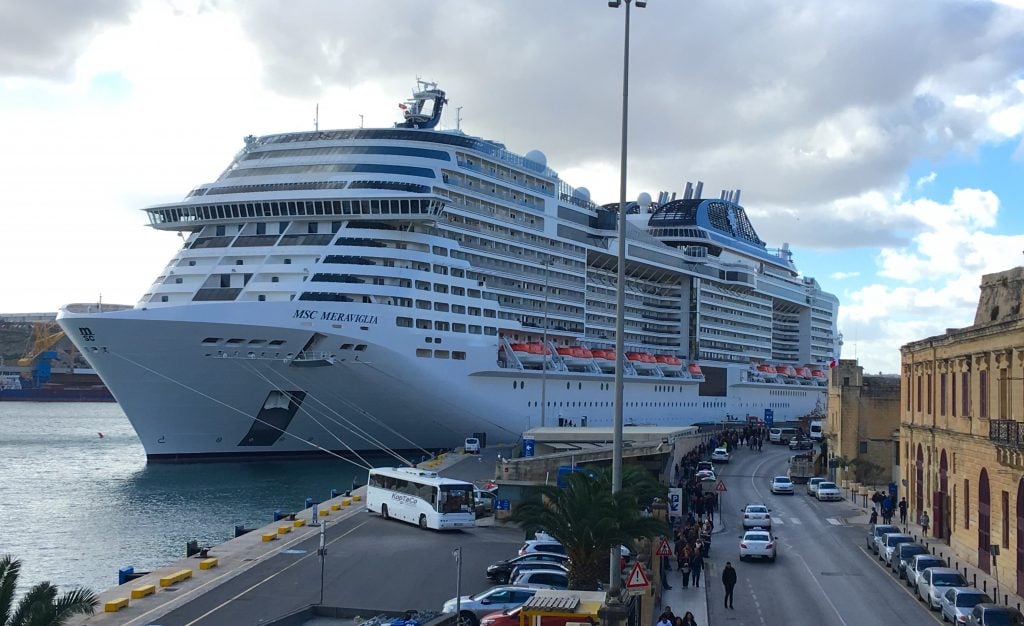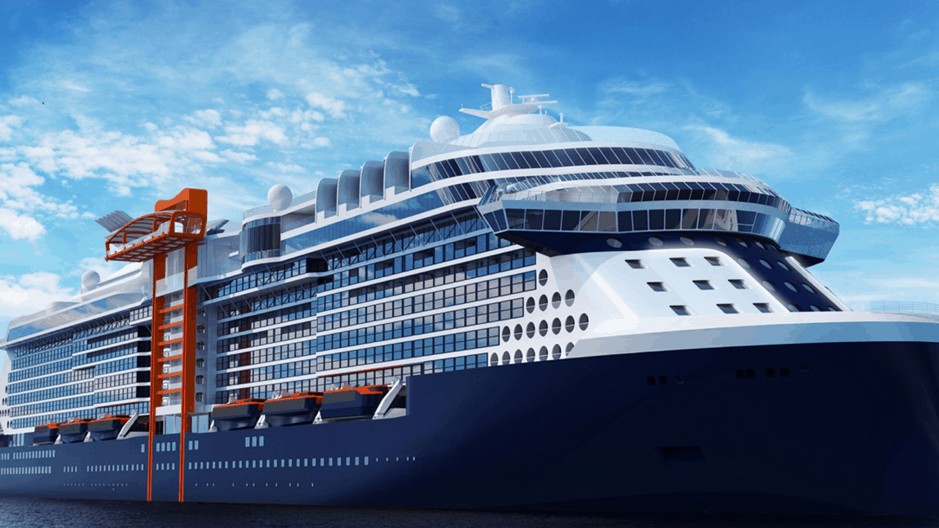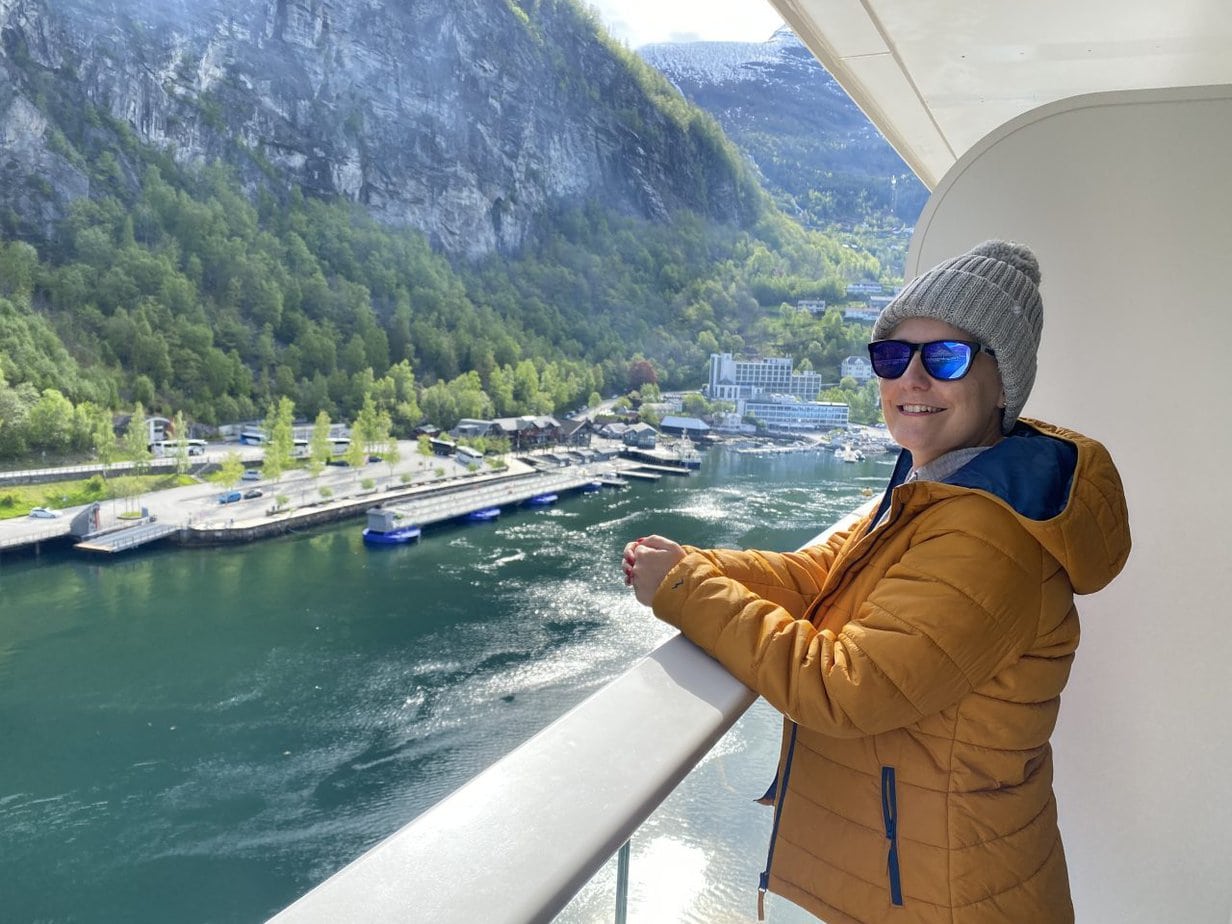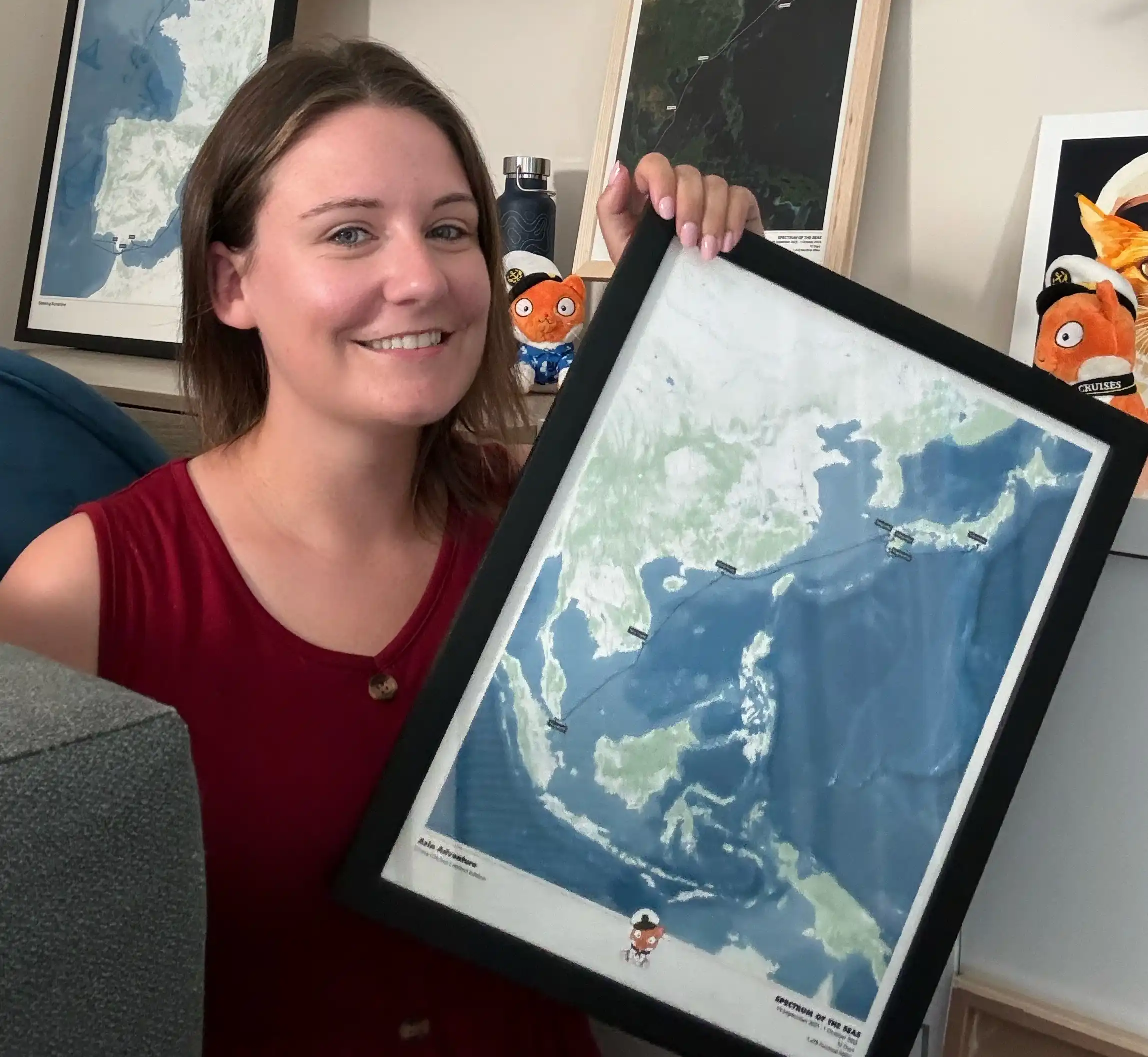If you’re someone who gets seasick easily, you will want to book the best cabin to minimise any risk of seasickness.
The last thing you want is to feel the motion of the ship all day and night, leaving you feeling unwell and spoiling your cruise!
I do get seasick – but I never go on a cruise expecting to feel ill! I have been seasick on only a handful of occasions and I have been on well over 50 cruises.
I am a very travel-sick/motion-sick person in general. I can feel ill on buses or coaches, and when I travel in the car I either drive myself or sit in the front so that I don’t feel sick. It never puts me off cruising though!
I have stayed in many different cabin types – from the cheapest Guaranteed inside cabin to balcony cabins and suites.
I don’t always take my own advice on seasickness and often choose a guaranteed cabin (where the cruise line picks the location) in order to save money. I know that the odds are stacked in my favour, and i am unlikely to be seasick.
Find out everything you need to know about booking Guaranteed cabins here:
I Always Book Guaranteed Cabins on Cruise Ships – (Photo Examples, Regrets & More)
Which Cabin to Book?
The best place to book a cabin on a cruise if you get seasick is on the lower decks and towards the middle of the ship.
Lower decks experience less movement than the higher decks, and the middle of the ship experiences less movement than the front or back.
Booking a cabin with a balcony can help, as you can easily get some fresh air and this often makes me feel better.
Consider Booking a Larger or Newer Ship
Another option to consider is booking a cabin on a larger cruise ship. Larger ships tend to have stabilizers, which help reduce the amount of motion felt on board.
Some cruise lines offer ships with advanced stabilizing technology, such as Royal Caribbean’s Quantum-class ships. They use a system of gyroscopes to keep the ship steady in rough seas.
By choosing the right cabin and ship, you have the best possible chance of enjoying a cruise without feeling seasick. You will be able to make the most of your time onboard.
Choosing the Right Cabin Location
If you’re prone to seasickness, choosing the right cabin location can make all the difference between having a comfortable and enjoyable cruise experience – or feeling unwell and wishing you had stayed at home! Here are some options to consider:
Upper Decks
Although you get a great view from an upper balcony cabin, and they are usually close to handy amenities like the pool and buffet – booking a cabin on one of the upper decks does mean that if you hit bad weather, you will feel the movement of the ship more than if you were on a lower deck.
Mid-Ship Cabins
Cabins located in the middle of the ship tend to experience less motion than those located at the front or back. If you book a low-down, central cabin you will feel far less movement.
Aft Cabins
Cabins located at the back of the ship offer great views. The motion of the ship tends to be more up and down – rather than rolling from side to side.
However, keep in mind that cabins at the back of the ship can be noisier, due to the ship’s engines.
When my parent stayed in an Aft balcony Cabin on the Emerald Princess, the noise and vibrations were very noticeable when the ship was docking or manoeuvring.
Find out all about staying in an Aft Balcony cabin here:
Cabins at the Front of the Ship
Cabins located at the very front of the ship tend to experience more motion than those located in the middle or back.
This is because the front of the ship is more exposed to the movement of the water as they plough through the rough seas. If you’re prone to seasickness, it’s best to avoid cabins at the front of the ship.
You may also find that even if you have a balcony or outside space, it might be too windy for you to open the doors! You want a little bit of fresh air – not a gale!
Choose Destination, Itinerary and Time of Year Carefully
If you’ll be visiting ports with rough seas – such as Alaska or the Norwegian Fjords, it’s best to choose a cabin located in the middle of the ship
You can get some really cheap out-of-season cruises, but this may mean you experience some bad weather.
I recently took a wonderful trip advertised as a cruise “In search of the Northern Lights.” It travelled to the top of Norway from Newcastle in the UK.
I took a Northern Lights cruise in February, and with hindsight, sailing across the North Sea in the winter months is not something that a person prone to seasickness should probably consider!
Despite taking sea sickness medication, I felt dreadful on the two-day crossing to and from Norway. I ate little and spent much of the time asleep!
Once we actually got to Norway and were cruising between the ports on the Norwegian coast I felt far better.
Unfortunately, this type of cruise to see the Northern Lights only sails during the winter months when the Aurora Borealis (or Northern Lights) are more visible. Seasickness was a chance I was willing to take!
Avoid Transatlantic or Transpacific journeys with many sea days! On most cruises, you only have the odd sea day here and there.
Usually, even if you are feeling sick, you will know that the next day you will be docked and you will feel fine again!
Choosing the Right Ship
How much cruise ships move in bad weather depends on a lot of things:
- The Size of the ship
- The Shape of the ship
- Whether the ship has stabilizers
- The age of the ship
- What that particular ship was designed for
The Size of the ship
Avoid smaller, older ships. As a general rule, small ships are lighter and more easily moved about in the waves than larger, heavier ships.
The Shape of the Ship Matters. I have found from personal experience that large, high, squarer ships – like the MSC Meraviglia and her sister ships for example – seem to fare less well in high seas and high winds.

Many ships are not streamlined, like the old Ocean liners of bygone eras! Cruise ship design has altered to accommodate as many balcony cabins as possible. These can leave them looking square and oddly top-heavy.
I recently sailed on the Celebrity Edge. This ship doesn’t have traditional balconies, it has “Infinite Verandas.” They have large opening windows, meaning the ship itself looks very streamlined.
When we did have one rougher “Sea Day.” The Captain said he was putting the stabilizers out, but we barely felt any movement. The winds on the top deck were very strong though!

Whether the ship has stabilizers. Newer ships are built with stabilizers. Ship stabilizers are fins or rotors mounted beneath the waterline that can come out laterally from the hull to reduce a ship’s roll due to wind or waves.
The age of the ship Older ships without Stabilizers move more! Even ships that have had stabilizers fitted later in their life are not as stable as more modern ships. (Fred Olsen’s Bolette, was retrofitted with stabilizers, she was originally built without them.)
Modern ships are designed very carefully to minimise movement when they are sailing.
What That Particular Ship Was Designed For
Most cruise ships fare very well, sailing along the coasts from one port to the next. If you are going a great distance – a Transatlantic crossing for example – cruise ships may struggle more crossing the rough Atlantic sea.
The only ship designed specifically for Atlantic crossings – with stronger winds and high seas – is the last Ocean Liner in service, Cunard’s Queen Mary 2.
If you are concerned about seasickness and wish to sail across the Atlantic, maybe consider sailing on this wonderful ship!
I took a short four-day cruise on her, travelling from Southampton to Hamburg and back. Although it was a winter crossing I was amazed by how stable the ship was, even at relatively high speeds.
Find out more about that memorable trip here:
Cabins with Balconies
If you’re prone to seasickness and want to enjoy fresh air and views, booking a cabin with a balcony may be a good solution for you.
Balcony cabins, provide a private outdoor space where you can relax and take in the scenery.
You can open the balcony door to let in some fresh air or close it to keep the air conditioning on. I personally find that fresh air makes me feel a little better if I am seasick.
If I don’t have access to a balcony cabin, I will go up to the top deck or to the promenade deck to find some fresh air if I am feeling unwell.
In addition to fresh air, balcony cabins also offer wonderful views. Whether you’re cruising through the fjords of Norway or the Caribbean Sea, a balcony cabin provides a front-row seat to the scenery.

Balcony cabins are usually more expensive than interior cabins, so it’s important to weigh the benefits against the cost.
I often travel in an inside cabin, and my parents book a balcony. I will happily go and sit on their balcony – rather than pay for the extra cost of a balcony cabin myself. Access to a balcony cabin is good enough for me, I don’t actually need to say in one!
Cabins with Windows or Portholes
If you’re prone to seasickness, booking a stateroom with a window or porthole may be a great way to improve your symptoms.
It is said that having a view of the outside world can help your brain adjust to the motion of the ship, making you feel more stable and less dizzy.
However, I find personally that if I can see the horizon moving up and down or from side to side as the ship sails, it makes me more aware I am at sea, and I sometimes feel even worse!
While staterooms with windows or portholes may be slightly more expensive than interior cabins, the investment can be well worth it if you want a view of the ocean. You can’t open the portholes to get any fresh air though.
If it gets rough, and you don’t want to see the rough seas outside, you can always shut the curtains!
Inside cabins
I often travel in inside cabins. I have stayed in cabins that are positioned front to back on the ship – or sideways so the face from one side to the other.
Once you are inside the cabin, you have no idea which way you are facing of course, but if the ship moves in rough seas, you will either be sliding up and down in your bed – or rolling from side to side! It is a curious feeling!
On one occasion, I slept on the floor – but this was on a winter sailing around the Mediterranean, so bad weather was not completely unexpected!
To hear all about my trip on MSC Meraviglia, read this article next:
What My Worst Seasickness Experience Taught me About Cruising
Deck Plans and Public Areas
Deck Plans
When booking a cabin on a cruise ship, it’s important to consider the deck plan.
If you’re prone to seasickness and don’t want to feel the motion of the ship, it’s best to choose a cabin on a lower deck.
The lower decks tend to experience less motion than the higher decks.
Additionally, cabins located in the middle of the ship tend to feel less motion than those located at the front or back of the ship.
Public Areas
The public areas on a cruise ship can also play a role in minimizing the feeling of motion. If you’re prone to seasickness, it’s best to avoid areas of the ship that are high up or at the front or back of the ship.
I remember when on a Christmas cruise from the UK to the Canary Islands, the worst place to be was in the buffet. This was situated at the back of deck ten. Our cups of tea were literally sliding across the table at breakfast!
We soon learnt to go down to the Coffee shop by the Atrium in the centre of the ship on deck 5 instead. The movement of the ship was much reduced there.
To hear more about that rocky Christmas Cruise, watch this video next:
Spending time in areas that are located in the middle of the ship and closer to the waterline will help you to feel any movement less.
The main dining rooms are typically located on the lower decks, making them a far better choice to eat in than the buffet, which is often at the top of the ship.
I find that eating bland food helps, as does avoiding alcohol. Green apples and ginger can also keep seasickness at bay. For my top tips to prevent seasickness, read this article next:
13 Actionable Tips to Prevent and Treat Seasickness on a Cruise
Preventing Seasickness
Medication
When it comes to preventing seasickness, medication is often the first option people turn to. There are several types of medication available, including many over-the-counter options.
It is important to do your research before you travel, and make sure any over-the-counter medication does not interact with any prescription medication you take.
If you forget to pack or run out of seasickness medication, go to the ship’s reception. They can often sell you some additional medication relatively cheaply.
Natural Remedies
If you prefer to avoid medication, there are several natural remedies that may help prevent seasickness.
Ginger, for example, has been shown to have anti-nausea properties and can be consumed in various forms, such as ginger tea or ginger biscuits.
Peppermint tea is another natural remedy that may help settle your stomach. For me, drinking Peppermint tea and eating Green Apples makes me feel far less sick.
Seasickness Wristbands
There are several Acupressure wristbands available that apply pressure to a specific point on the wrist. This is believed to help prevent nausea.
This is a popular alternative to medication. These wristbands are often inexpensive and can be found at most chemists.
While they may not work for everyone, many people find them to be effective at preventing seasickness
I recently bought a more expensive seasickness band that gives you small electric shocks. It is too early to say if it will work for me – but the shocks certainly take my mind off of the seasickness!
Seasickness Patches
Another alternative is seasickness or motion sickness patches. You apply the patch as directed on the packet, and they are said to prevent travel sickness for up to three days.
I have never used these myself, but some people find them very effective.
Other Things to Think About
Dining and Snacking
When it comes to dining and snacking on a cruise ship, it’s important to choose foods that are easy on your stomach. I often stick to things like bread rolls and fruit, and I avoid heavy or greasy foods if I am feeling unwell. Large meals make me feel worse.
I find Green Apples, anything containing Ginger, and Peppermint Tea can all help settle my stomach.
Keep Well Hydrated
Staying well hydrated is important, as dehydration can make motion sickness symptoms worse.
Drink plenty of water and avoid alcohol, which can dehydrate you. Luckily for me, I rarely drink so avoiding alcohol is never a problem!
Rest assured, if you plan ahead and take reasonable precautions, you are unlikely to get seasick on your cruise!
Before You Go
If you are unlucky enough to become unwell, or you have an accident whilst onboard, Cruise ships have medical centres onboard that are staffed by doctors and nurses.
These medical centres are very well equipped to deal with most medical emergencies, but they can be expensive. Find out all about the medical centre’s onboard cruise ships here:
How Much Does Medical Care Cost on a Cruise? Real Examples (X-Rays, Consultations & More)
Make sure you take out adequate travel insurance to cover medical expenses! To find my full guide on why you need Travel Insurance and how to get it, click here:
Cruise Travel Insurance – Why You Need it and How to Get It: (Step by Step Illustrated Guide)
Let Us Help You Book Your Next Cruise
If you are looking to book your next cruise adventure, my friendly, knowledgeable partner travel agents can help!
If you are not sure which cruise would suit you, they can help you find something that best suits you and your family.
It never costs more than booking directly with the cruise line, you can get free, impartial advice – and often a better price or added extras – like onboard credit – that you wouldn’t get booking direct.
Click below and Fill in the form – and we will get back to you:

Free Insiders Cruise Line Guide
Ever wondered how the mainstream cruise lines compare? Cruise lines won’t tell you this, but I will.
This FREE guide shows you everything you need to know to find your perfect cruise line.
Whenever I take a cruise I order a print of my trip. It uses the real satellite data from the cruise and is always a great conversation starter!
I'm building an impressive collection...
Code EMMACRUISES will get you 10% off

